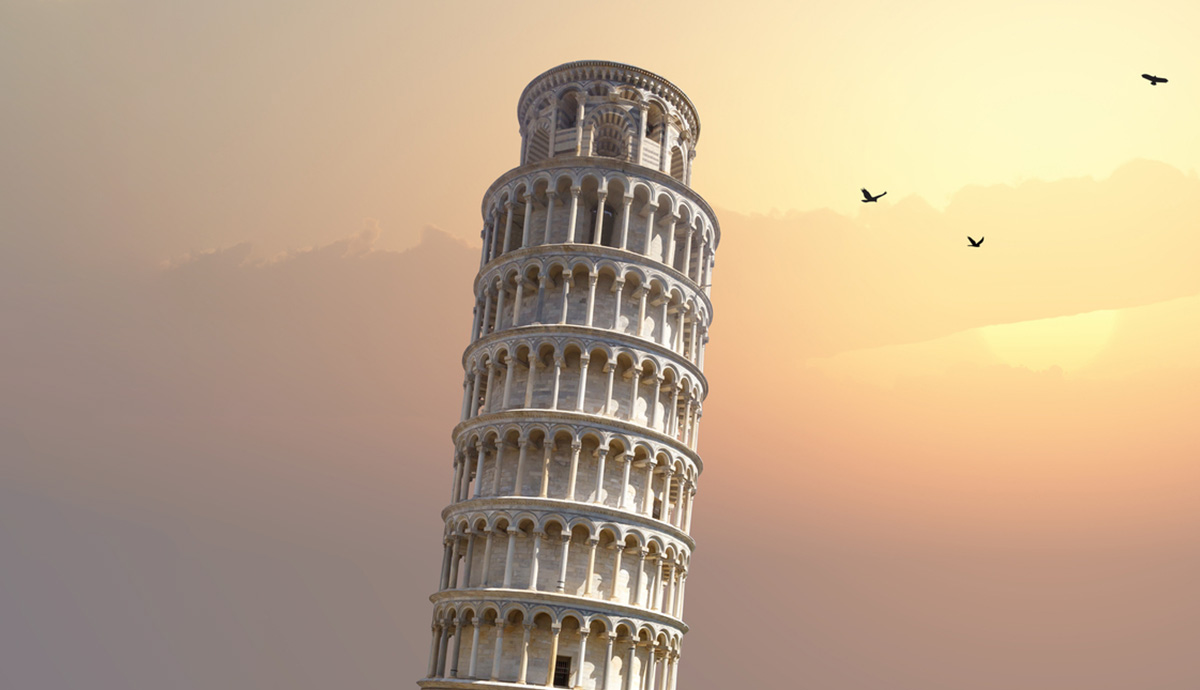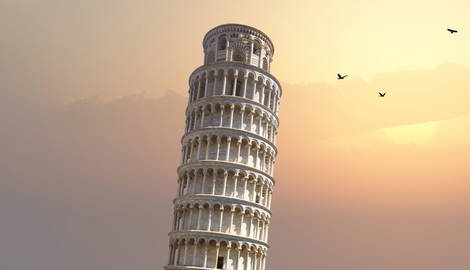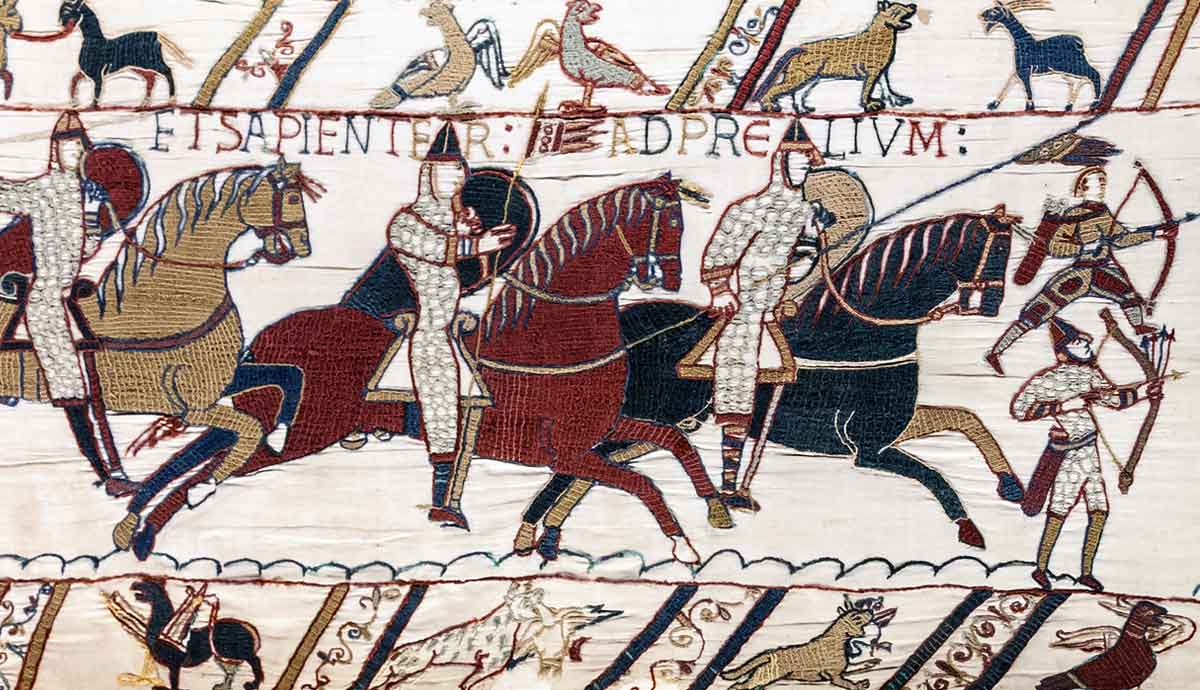
In 1990, the Leaning Tower of Pisa closed to the public. The building had been steadily subsiding southward since the late 20th century, and engineers feared it was on the verge of collapsing. That the white marble structure would not be like a regular tower had been clear from the beginning. In the 12th century, when the Leaning Tower of Pisa was only three stories high, the leaning problem was already evident. Subsequent attempts to straighten it were all unsuccessful, resulting in the peculiar “banana shape” of the tower. Read on to discover more about the Leaning Tower of Pisa.
Why Is the Leaning Tower of Pisa Leaning?

Italian writer Gianni Rodari described the Leaning Tower of Pisa as a necessary and beautiful mistake, declaring: “Mistakes are necessary, useful as bread and often also beautiful: for example the tower of Pisa.” Indeed, while most towers stand tall, the worldwide fame of this medieval structure stems from its odd shape and noticeable southward slope. Inventing creative “holding up” poses has become almost a must for the millions of tourists who visit the tower every year. But why exactly does the Leaning Tower of Pisa lean?
Geological studies have shown that the leaning is due to a foundation problem. Like the entire plane of Pisa, the subsoil of the square where the tower is located is made by “lagoon and marsh deposits” that consist of “silts, clays, and fine sands intercalated with the wind-borne sands of the ancient coastal dunes.”

Geotechnical engineers have identified four distinct layers in the soil beneath the Leaning Tower of Pisa, each with its unique properties. Estuarine deposits, such as sands and clays, make up most of the upper layer. The second layer, which reaches a depth of about 131 feet, consists of marine clays. According to experts, the pliable “upper clays” (known as Pancone in Italian) are responsible for the foundation problem that resulted in the southward inclination of the tower.
Professor John Burland of Imperial College London, one of the engineers leading the restoration efforts, likened the soil under the Leaning Tower of Pisa to a soft carpet. After reaching a critical weight and height, it starts to compress, causing a leaning instability to the structure. Indeed, the tower began to lean (first northward and then southward) in the early stages of its construction. A sudden halt in the construction due to a series of wars likely saved the initial stores from collapse, as it allowed the foundation to settle.
Where in Italy is the Leaning Tower of Pisa Located?

The city of Pisa, where the tower is located, lies in Tuscany on the plain of the Arno River, about 50 miles west of Florence. First a Roman colony and then a Christian bishopric, Pisa, unlike many other Italian cities, managed to survive the fall of the Roman Empire. Due to its proximity to the Tyrrhenian Sea and fertile hinterland, Pisa became a flourishing commercial center in the 11th century.
In 1016, with the assistance of Genoa, the Pisans forced the Saracens out of Sardinia. Then, in 1063, Pisa widened its hold on the Mediterranean Sea by sacking Muslim Palermo. In the 12th century, the city’s traders established several settlements in Syria during the Crusades. By then, Pisa had become a major naval power in the Italian peninsula, rivaling cities such as Venice and Genoa.

As Pisa’s political strength grew, so did the wealth and civic pride of its residents. Work on the Cathedral began in 1063 in what would later be known as Piazza dei Miracoli (Square of Miracles). A testament to the city’s identity and power, the cathedral was built using materials from the Roman monuments as if to depict Pisa as a “second Rome.” On the facade, an engraving tells visitors that the treasures pillaged from Palermo funded the building’s construction. In 1152, the city began erecting a circular Baptistery near the Cathedral. The Camposanto (cemetery), founded in 1277, was the last monument added to the square before the tower.
The Piazza dei Miracoli derives its evocative name from a passage in Gabriele D’Annunzio’s Forse che sì forse che no (Maybe Yes, Maybe No). In the 1910 novel, the story of the passionate affair between Paolo Tarsis and Isabella Inghirami, D’Annunzio mentioned the square while describing Paolo’s flight over Pisa: “The Ardea [the name of the plane] circled in Christ’s sky, over the prato dei Miracoli [meadow of miracles].” In 1987, the square was added to the UNESCO World Heritage Site list.
When Was the Leaning Tower of Pisa Built?

According to Giorgio Vasari’s 16th-century The Lives of the Most Excellent Painters, Sculptors, and Architects, “Guglielmo … in the year 1174, together with the sculptor Bonanno, laid the foundations of the belfry of the cathedral in Pisa.” There is little record of the construction process, but a carving on the entrance of the tower states that work began in August 1173.
A sculptor active in Pisa in the 11th century, Bonanno later created the bronze Porta Reale (destroyed by a fire in 1595) and Porta San Ranieri for the Cathedral. In the 19th century, fragments of a funerary inscription with his name were found at the foot of the tower. His signature, Bonanno civis pisanus (Bonanno Pisan citizen), is also carved on the gate of Monreale Cathedral in Palermo, Sicily. In 2019, Giulia Ammannati, a researcher at the Scuola Normale Superiore of Pisa, confirmed Vasari’s attribution to Bonanno while restoring the full text carved in the funerary inscription: “I who, surely, have erected, founding it, an admirable work, am the Pisan citizen named Bonanno.”
The first three floors of the tower were constructed between 1173 and 1178. The structure was meant to act as the bell tower of the nearby Cathedral. After the masons added the third floor, however, the foundation began to settle unevenly, and the tilt became immediately visible. As masons and architects began to work on a solution to the leaning problem, construction came to a halt. Indeed, a ca. 1233 parchment containing the first known depiction of the Leaning Tower of Pisa shows the initial three floors topped by a dome.

In the 1280s, architect Giovanni di Simone resumed work at the tower and attempted to correct the inclination by making the new floors taller on the building’s shorter side. Di Simone’s efforts, however, were disappointing as the tower sank deeper into the ground. Thus, construction paused again. The uneven height of the marble blocks also resulted in a banana-shaped structure, with the bell chamber slightly closer to the perpendicular than the base.
Meanwhile, the rivalry between Pisa and Genoa worsened, as both maritime republics sought to control the trading routes connecting the Tyrrhenian Sea with Sicily, North Africa, and the Middle East. Around 1282, war broke out between the two cities. Two years later, in August 1284, the two rival fleets clashed in the Battle of Meloria, one of the biggest naval battles of the Middle Ages. The day ended with Pisa’s defeat.
Despite its defeat, the city managed to retain its independence and remained a leading Tuscan center in the 13th and 14th centuries. It came under Florence’s control in 1406. In the 1380s, Simone Pisano finally completed the tower, bringing to a close a centuries-long, arduous construction process. The tower stood 185 feet high and weighed 14.453 tonnes, and it was still leaning.
What’s Inside the Leaning Tower of Pisa?

The Leaning Tower of Pisa has a hollow cylindrical body. Two staircases, totalling 294 steps, lead to the top of the tower. The first one starts from the base and reaches the sixth floor, where a second narrower helical ramp leads visitors to the bell chamber. As in many Romanesque-style buildings, a series of feritoie (single-lancet windows) in the walls allow for dim lighting. The steps show signs of erosion in the middle after centuries of use.
The bell chamber offers visitors a panoramic view of Piazza dei Miracoli and Siena’s city center. There, it is also possible to take a closer look at the seven bells, one for each musical note: Assunta, Crucifix, San Ranieri, Dal Pozzo, Pasquareccia, Terza, and Vespuccio. Originally named Giustizia, the San Ranieri bell (named after Pisa’s patron saint) was once located in the Palazzo di Giustizia (Courthouse), where it rang to announce the sentencing of a traitor to death. At the center of the chamber, a glass panel covering an opening in the floor adds some light to the dimly lit interior.
Upon stepping into the entrance, the Leaning Tower of Pisa’s slope is immediately noticeable, as the floor is inclined southward. The tilt of the structure remains visible while climbing the stairs.
Will the Leaning Tower of Pisa Fall?

Over the centuries, several architects and engineers tried to find a way to reduce the Leaning Tower of Pisa’s tilt. Around 1838, Alessandro Gherardesca added a marble walkway around the construction, believing it would help strengthen the foundation. The excavation, however, nearly caused the tower to collapse. Equally unsuccessful was the 1934 attempt to stabilize the base with grout injections. The tower’s lean continued to grow.
At the end of the 1980s, the Leaning Tower of Pisa was tilting 5.5 degrees (about 15 feet) from its perpendicular. In 1989, its tilt increased from 0.04 inches to 0.08 inches. Despite the injection of grout and various reinforcements, it became clear that the famous Italian hallmark was in danger of collapse. Thus, in 1990, the tower was closed to the public for nearly 12 years, as geotechnical engineers embarked on a delicate restoration process.
While previous stabilization projects had tried to add cement and weights to straighten the tower, this time, the engineering team opted to extract the soil from beneath its foundation. First suggested in 1962 by Leonardo Terracina, the method of underexcavation had already been employed to correct the lean of bell towers in England and Holland.

The drilling program in Pisa began in February 1999. For the next three years, 41 corkscrews extracted soils from the south side of the tower. At the same time, lead weights were added on the north side and steel cables attached to the third floor to prevent the tower from falling in case something went wrong.
Initially, the extraction seemed to be unsuccessful. Then, the tower finally began to rotate toward its north side. By June 2000, the medieval structure’s leaning had been corrected by six inches. In 2001, the restoration project ended, and the tower reopened to the public.
With the stabilization work, the tower is expected to remain stable for about 200 or 300 years. As long as its center of gravity falls within its base, the Leaning Tower of Pisa will remain standing. Today, a series of sensors ensures the structure’s stability, and the biggest threat to its survival is the possibility of a strong earthquake hitting Tuscany or Pisa.










